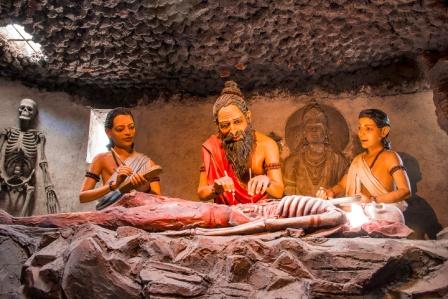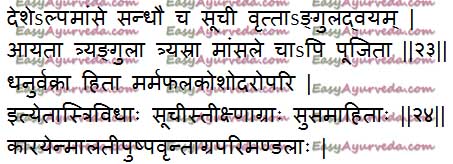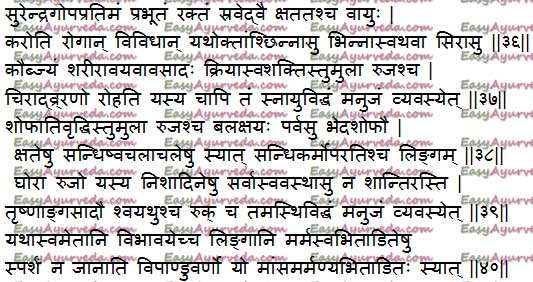Sushruta’s 8 Types Of Surgical Procedures – Astavidha Shastra Karma
By Dr Renita D’Souza
Master Sushrutha has mentioned eight types of surgical techniques. 1. Chedana – excision 2. Bhedana – incision 3. Lekhana – scraping 4. Eshana – probing 5.
Read – Shastra – Surgical Instruments Of Ayurveda: Astang Hriday Sutrasthana 26
Table of Contents
Vagbhata’s surgical procedure
Master Vagbhata mentioned 6 types of surgical procedures
1.
2. Vyadhana
3. Chedana
4. Lekhana
5.
6

Master Vaagbhata mentioned 13 types of surgical procedures
1. Chedana 2. Bhedana 3. Lekhana 4. Eshana
5. Aaharana 6. Vedhana 7. Visravana 8. Seevana 9. Uthpaatana – elevation and extraction
10. Kuttana – multiple pricking 11. Mandhana – churning and drilling 12.Grahana – holding 13. Dahana – cauterization
Read – Yantra Instruments used in Ayurveda: Ashtanga Hruday Sutrasthana 25
Chedana
Chedana – Excision Diseases that require excision –
Bhagandara – fistula-in-
Bhagandara – fistula-in-
Arshas – piles Charmakeela – warts Asthimamsagam
Bhedana
Bedhana – Incision Diseases that require the incision
All types of
3 kinds of
First three types of
Read –Vruddhi Causes, Types, Symptoms, Prognosis, Ayurvedic treatment
Vidarika – carbuncles
Prameha
Anushahi – boils on the head Nadi
Vrindha (tumours of the throat) – two kinds of
Alaji – inflammation of eye
Shudra
Tundikeri – tonsillitis
Those diseases requiring excision, as mentioned above, when they attain suppuration at that stage incision or bheda is indicated. Basthi Ashmari – bladder stones Diseases produced by fat tissue
Read – Urinari calculi – Home Remedies, Ayurved Treatment, Diet, Recipes
Lekhana
Lekhana – Scraping Diseases that require scraping
4 types of rohini – vataja, pittaja, kaphaja, sannipataja Kilasa – leucoderm (Read – Vitiligo: Ayurvedic Treatment, Medicines, Herbs, Remedies) Upajihvika – swelling in the tongue Medajo dantavaidarbhyo – danta vaidarbhya (gingivitis) originated by fat tissue
Medaja granti – tumour originated by fat tissue
Medaja vartma – fat origin tumours of eyelids
Adhijihvika – adenoids
Arshas – piles
Mandala kusta – variety of skin disease
Mamsakanda – muscle tumor Mamsa unati – thickening of the muscle
Read – Charak Samhita Kushta Chikitsa – 7th Chapter
Vedhana, Eshana
Sira
Read – Siravyadha Method Of Bloodletting: Procedure, Precautions, Benefits
Eshana – Probing Diseases that require probing
Nadi – sinus ulcers Sa
Read – Kshara Sutra application in Fistula in ano (Bhagandara)
Aharana, Visravana
Visravana (Draining) Diseases that require draining procedure
Five types of
Vishajushta shonitam – blood vitiated by poison Arbudani – all types of tumours
Visarpa – all types of erysipelas Grantyascha adistu – first types of granti (benign tumour) – vataja, pittaja and kaphaja Trayascha upadamsha – vataja, pittaja and kaphaja syphilis
Stana roga – diseases of breast Vidarika – diabetic carbuncles Sausira – tooth sinus
Gala shalooka – epiglottitis Kantakah – inflammation of tongue Krimidantaka – dental caries
Danta veshta – gingivitis
Upakusha – ulcerative gingivitis
Shitada – spongy gums
Danta pupputa – gingivitis Pitta
Read – Home Remedy For Gum Swelling And Bleeding Gums
Indications for suturing
Sevana – Suturing Diseases that require suturing
Medah samuthasch – diseases of fat origin Bhinna – cut/ incised wound Sulikhita gadah –
Contraindications for suturing
Shara
Visha
Maruta
Materials for suturing
Materials used in ancient times for Suturing

Reference – Shushrutha sutra
Type of Suture

Reference – Sushrutha sutra
Needles
Types and Qualities of ancient Needles used in Surgery

Reference – Shushrutha sutra sthana 25/23, 24
In ancient period master Sushrutha has mentioned 3 types of suchi (needles) based on the site of injury. 1. Vrutta – round needle
Features – Length – 2 angula This type of needle is used to suture the area where there is less muscle tissue. 2. Needle with 3 angula long and having 3 edges (tryasra). This type of needle is used to suture broad and fleshy area of injury. 3. Dhanurvakra – needle curved like bow. This type of needle is used for suturing vital pionts (marma), Phala kosha (scrotum) and abdomen (udara).
General features of Suturing Needles- Theekshnaagra – tip of the needle should be sharp Susamahitha – manufactured evenly
Malati pushpa vrunta aagra parimandala – hind tip resembling stalk of malati flower and round.
Read – Diseases Due To Pathological Muscle Tissue – Mamsa Pradoshaja Rogas
Suturing method
Ancient method of Suturing
Reference – Su. Su 25/20 – 26
The wound should be elevated and placed in normal position. Then suturing should be done using the suitable suturing material and needle. Suturing should be done neither very far nor very close. If the sutures are far apart it will give rise to pain in the edges of the wound and if very near edges will get torn.
After suturing – After suturing, the wound should be sprinkled with – powder of priyangu, anjana, licorice and rodhra or shallaki phala churna – powder of shallaki fruit or Ash of linen cloth Then it should bandaged appropriately. Patient is advised to follow suitable regimen.
Complications
Shastra Karma Vyapat (Complications of surgery)
There are four kinds of complications that can occur in 8 types of surgical procedure. 1. Hina cheda – inadequate cutting 2. Atirikta cheda – excess cutting 3. Tiryak cheda – oblique cutting 4. Atmana – cutting own body
Shastrakarma Vyapat lakshana (symptoms of complications) Reference – Shushruta sutra sthana 25/34, 35

Following are the common symptoms that occur when vital points, joint, veins, tendons and bones are injured especially the vital points.
Brhma – giddiness
Pralapa – incoherent speech
Patanam – fainting
Pramoha – delusion
Vicheshtana – loss of body activities
Samlayana – Lying down unconsciously
Ushnata – increase of body temperature
Srastangata – weakness of body parts
Murchana – unconscious
Urdvavata – gasping
Tivra rujo vatakrtascha – severe pain due to vata imbalance
amsodakaabham rudhiram cha gacheth – the blood resembles as if mixed with muscle tissues. Common symptoms of injury to sense organs and marma points.
Read – Bleeding Disorders: Ayurveda Treatment, Diet, Home Remedies
Features of injured parts
Features when specific parts are injured during surgical procedure Reference – Su.Su 25/36-40

Injury to veins –
Profuse bleeding which resembles the color of indragopa (cochineal insect) Vata gets aggravated giving rise to many diseases.
Injury to ligaments – Kaubjya – Shortening Debility of body parts and inability to perform thier functions Severe pain Healing of the wound takes long time
Read – Local Pichu Treatment For Painful Joints, Ligaments And Muscles
Injury to the Joints – Increase of swelling Severe pain In joints there is loss of strength, splitting pain, oedema and loss of function.
Read – Sandhi Shareera: Study of Bone Joints As Per Ayurveda
Injury to the bones – Severe pain day and night Finds no comfort in any posture constantly Thirst Body debility, oedema and pain
Read – Asthi Shareera – Definition, Anatomy, Types Of Bones
Injury to marmas (vital spots) The above symptoms together with symptoms pertaining to the particular injured vital spot will be present. Injury to the vital spots of muscles – loss of touch sensation, paleness of the body.
Click to Consult Dr Renita D’Souza










One comment
Prachi jain
Quite good and easy to understand ma’am.